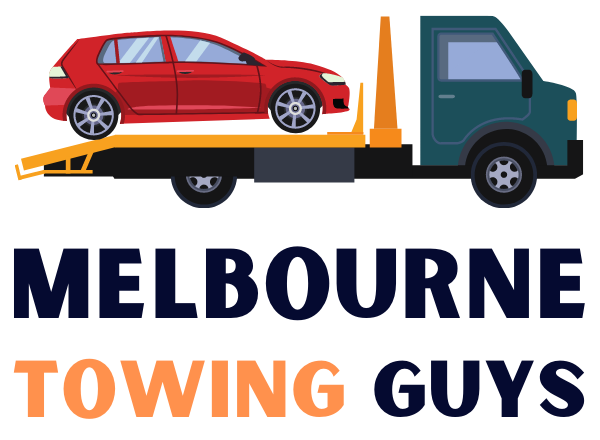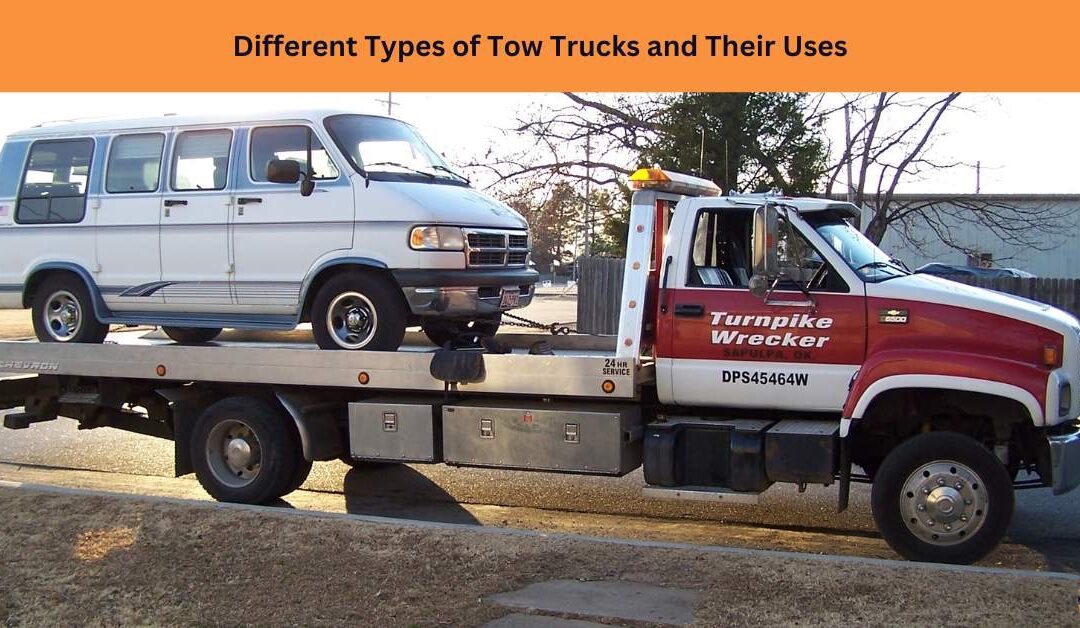Tow trucks are a lifeline when you’re stranded with a broken-down vehicle, involved in an accident, or need to transport a vehicle over a long distance. However, not all tow trucks are the same; different types are designed to handle various towing needs, depending on the situation, vehicle type, and environment. Here’s a look at the main types of tow trucks and what each one is best suited for.
1. Flatbed Tow Trucks
Flatbed tow trucks, sometimes called “rollback” trucks, feature a long, flat platform (or bed) on the back that can be tilted and lowered to the ground. The vehicle needing a tow is either driven or winched up onto this bed, which is then leveled and secured for safe transport.
Uses of Flatbed Tow Trucks
Flatbeds are ideal for:
All-Wheel Drive (AWD) and Four-Wheel Drive (4WD) Vehicles: Since all four wheels are lifted onto the bed, there’s no risk of damaging the drivetrain, which can happen if only two wheels are lifted off the ground.
Luxury, Exotic, and Classic Cars: Flatbeds provide the safest towing method for high-value vehicles, ensuring no additional wear or risk of contact with the road.
Heavily Damaged Vehicles: After an accident, a vehicle may not be in any condition to roll on its wheels, making flatbed towing essential.
Flatbed tow trucks are widely regarded as the safest method of towing, especially for transporting a vehicle over long distances, as they avoid contact with the road entirely.
2. Wheel-Lift Tow Trucks
Wheel-lift tow trucks use a metal yoke that slips under either the front or rear wheels of the vehicle, lifting it off the ground. The non-lifted wheels remain on the road as the vehicle is towed. Unlike traditional hook-and-chain towing, wheel-lift towing reduces potential damage by lifting the vehicle from its wheels rather than hooking under the bumper or frame.
Uses of Wheel-Lift Tow Trucks
Wheel-lifts are suitable for:
Short Distance Towing: Ideal for quick tows, such as transporting a vehicle a few miles to a nearby repair shop.
Tight Urban Areas: Wheel-lift trucks are often more maneuverable than flatbeds, allowing them to navigate narrow streets and fit in confined spaces.
Towing Light to Medium-Sized Vehicles: They are generally used for smaller cars and vehicles that can withstand the partial contact with the road.
While wheel-lift tow trucks are generally safe for most standard vehicles, they are not recommended for all-wheel drive or high-end cars.
3. Hook and Chain Tow Trucks
One of the oldest towing methods, hook and chain trucks use a heavy-duty chain attached to the vehicle’s axle or frame. The chain is then connected to a large hook on the tow truck, and the vehicle is lifted and towed with two wheels on the ground.
Uses of Hook and Chain Tow Trucks
These trucks are often used for:
Scrap and Junk Vehicles: If a vehicle is being taken to a scrapyard, where potential damage isn’t an issue, hook and chain towing is an affordable and practical option.
Impounded or Severely Damaged Cars: Hook and chain trucks are commonly used in impounding situations where the vehicle’s condition is not a priority.
Off-Road or Heavily Damaged Vehicles: The durability of the chain makes it ideal for towing vehicles from difficult terrain or when they cannot be lifted by other means.
Although effective for certain purposes, this method can damage the bumper, suspension, and other components, so it’s rarely used for operable vehicles or those with sensitive frames.
4. Integrated Tow Trucks
Integrated tow trucks, also known as “self-loader” or “repo” trucks, combine the benefits of wheel-lift and hook-and-chain methods with advanced hydraulics. They feature a hidden arm that can quickly extend and lift the wheels of a vehicle, making the process fast and efficient. These trucks are often equipped with additional axles for stability and strength.
Uses of Integrated Tow Trucks
Integrated tow trucks are ideal for:
Repossession: They’re commonly used by repo agents due to their ability to quickly secure and lift a vehicle without needing to leave the cab.
Heavy-Duty Vehicles: Integrated trucks are robust and can handle larger vehicles, such as buses, RVs, and heavy trucks.
Emergency Situations: The speed and ease of operation make them ideal for quick roadside assistance or situations where the vehicle needs to be moved immediately.
With their powerful arms and extra stability, integrated tow trucks provide a reliable option for heavy-duty tows and quick repossession operations.
5. Boom Trucks
Boom trucks are equipped with a hydraulic arm, or “boom,” that can lift and tow vehicles. The boom arm extends outwards, making it possible to lift vehicles from ditches, tight spots, or steep inclines. Boom trucks usually also have a hook-and-chain system but offer greater reach and flexibility than traditional tow trucks.
Uses of Boom Trucks
Boom trucks excel in:
Recovering Vehicles from Difficult Terrain: The arm can reach vehicles that other tow trucks can’t, such as those stuck in ditches or rough terrain.
Accident Recovery: After an accident, vehicles may end up in places that aren’t accessible by a regular tow truck, making a boom truck necessary.
Heavy-Duty Towing: Some boom trucks are designed to tow large vehicles, like semi-trucks or construction equipment, due to their powerful boom arm.
Boom trucks are essential for heavy-duty towing and recovering vehicles from places where other tow trucks cannot reach.
6. Rotator Tow Trucks
Rotator tow trucks, sometimes known as “crane” tow trucks, feature a powerful crane that can rotate 360 degrees. These are the giants of the towing world, equipped to lift extremely heavy vehicles and access areas that no other tow truck could. Rotator trucks are complex and require a skilled operator, making them one of the most specialized and expensive towing options.
Uses of Rotator Tow Trucks
Rotators are invaluable for:
Clearing Accident Sites: When large vehicles like tractor-trailers overturn on highways, rotator tow trucks can lift them and clear the wreckage quickly.
Heavy Equipment Transport: They are commonly used in construction and transport industries to handle large machinery.
Rescue Operations: In the case of emergency rescue, rotators can provide the reach and power necessary to retrieve vehicles from extreme positions, such as over embankments or ravines.
These trucks are highly versatile but are typically reserved for the most demanding and heavy-duty recovery operations.
Choosing the Right Tow Truck for the Job
Selecting the right tow truck depends on several factors: vehicle type, location, and the towing requirements. Here are some guidelines for choosing the right type:
For Standard or Light Vehicles: Wheel-lift tow trucks are often the best option for short distances, while flatbeds are ideal for all-wheel-drive and luxury cars, providing maximum safety.
For Vehicles in Tight Spaces: Integrated tow trucks work well in urban settings and for situations requiring fast retrieval, such as repossessions.
For Off-Road Recovery or Severe Damage: Boom trucks or rotator trucks are best for pulling vehicles from hard-to-reach areas.
For Heavy Vehicles or Machinery: Rotator and integrated tow trucks provide the strength needed for towing trucks, buses, and large equipment.
Each type of tow truck has a specific set of strengths, and understanding these options can help in deciding which service is best suited for different towing needs. Whether you’re transporting a classic car across town or need a big rig pulled out of a ditch, the right tow truck ensures safe and efficient transport tailored to your unique situation.
If you are in Glen Waverley, Victoria 3150, Australia and looking for a tow truck service or roadside assistance service, this is the best way to visit us.
Melbourne Towing Guys
12 Esperance Rd
Mount Waverley VIC 3149
(03) 7037 7636


Recent Comments